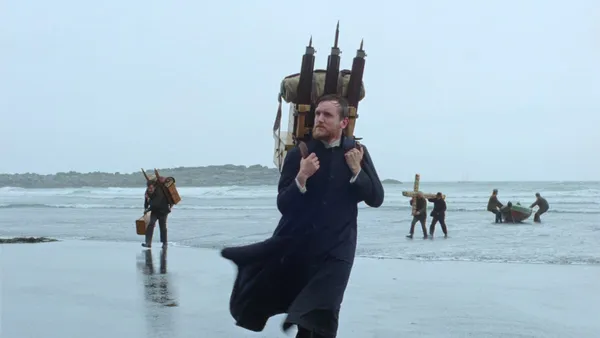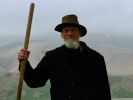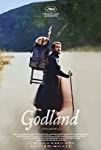Eye For Film >> Movies >> Godland (2022) Film Review
Godland
Reviewed by: Dora Leu

Every so often there comes along a film so impressively monumental that you feel it’s already a classic piece of cinema. Be it its religious-cum-historical theme or its awe-inducing 35mm shots, there is an aura of timelessness that surrounds the perfectly titled Godland. Precise and slow, Hlynur Pálmason’s tale of doubt-stricken faith rolls out as if it were an essential story, lifted straight from the literary canon of the 19th century that it is set in.
A young Danish priest (Elliott Crosset Hove, as Lukas) is sent out as a civilising missionary to build a church in Iceland, which provides fertile ground for a clash between nationalities and cultures. There is a stroke of colonial arrogance in the way the priest behaves, often aimed at his Icelandic companions on the journey, particularly at his stern head-guide, Ragnar (Ingvar Eggert Sigurðsson). Smouldering tensions add up as they move through valleys and adverse weather, each trying the other’s patience. They crucially don’t speak each other’s language, and more than misunderstandings, they actively refuse to understand one another. Lukas feels like the entitled erudite and Ragnar is the all-knowing, tried local.

Yet for the viewer both are ambiguous. The priest is a fool, falling off donkeys (to Ragnar’s amusement), underestimating if not disrespecting the land, but he is also a young idealist, carrying a photographic contraption on his back like the sign of a self-imposed romantic martyrdom. He is arrogant, but not confrontational, and he is able to be kind to those who are willing to accept him, as does his friendly translator - and often that kindness is the act of taking a photograph. Photography later even becomes an act of love, as he reaches his new parish in Iceland and falls for the elder daughter of his new host.
Pálmason’s film is not so much a Jobian-like religious story about a man tested by God on uncertain shores - even if Lukas may gullibly comfort himself in thinking so - as it is a parable about creation and, by extension, image and medium. Behind the quest to further and farther spread the Christian word to a heathen land, Lukas’ mission is that of recording, of making an account of those he meets and whom the camera has never seen before. Godland begins with a title card announcing some very first Icelandic photographs that acted as inspiration for the story - some mysterious images that we never lay eyes upon, and for that matter, as Pálmason confessed, may never exist, but which we cannot help feeling they are being recreated as characters are facing the camera.
We often see Lukas at work and we, too, look through a virtual viewfinder at those he photographs, with them standing quietly and composedly in front of the camera, in long, minute-length shots. Yet other times Pálmason is transgressive, and what would appear as photographs being taken are occasional codas to scenes, taken from unclear perspectives. Is it God’s point of view, one might wonder.
The brilliance of Godland is that it is, at its essence, a work of cinematic ekphrasis. Its slow rhythm and overt referential interest for capturing images act as if codifying and explaining in real time the process of wet-plate photography. Lukas’ technique not exactly of choice but of historical accuracy is a process that requires time, waiting and little movement, if not also a certain reverence for the camera at a point when photography was still a novel medium. The priest is thus very careful who to photograph, and even resists taking a picture of Ragnar for as long as he can manage.
Beyond theological drama, Godland and Lukas’ journey to a previously unphotographed land can be unexpectedly theoretical, issuing an unverbalised commentary on photography, and so, on film, as a document or as having anthropological value. After all, wet-plate photography was primarily a medium suitable for portraiture. More reflexivity is added to Godland by the fact that it is unmistakably shot on film, which, given that film has now become more of an artisanal medium, rather invites you to draw a parallel between the priest and the filmmaker as artisans working with techniques in danger of disappearing. Even if photography is more of the direct subject, Palmáson’s film is an undeniable cinematic achievement. His calibrated shots make you feel as if time is flowing through them, through cinematic time and scene length, but also through inspired montages of seasons passing. Cinema as continuum and photography as instance come into beautiful dialogue in Godland.
Palmáson’s film is very well anchored in the artistic zeitgeist of its time, which makes its past tense, time long gone-by setting feel very present. As if in dialectic with the portraits of its people, the film's greatest achievement are its landscapes. While it may not be directly borrowing from iconic pictures, Godland’s imagery operates within a very specific spirit of Nordic landscape painting and 19th century Romanticism, where nature is imbued with a religious sentiment. Think of the feeling of a Caspar David Friedrich painting. An overwhelming, picturesque and vast space, where man dissolves as insignificant. So are also the landscapes of Godland, cold shores of an angry sea, muddy bogs and wet vegetation, tall mountains and rocky valleys - but all ever so bright in the Icelandic sun, as if nature was as inviting as it was impassable. Faith fails in Godland. God has not deserted, instead he is replaced by nature, a textured, visceral nature that is as beautiful as it is fear inducing. Prayers are useless in front of the cold and rain, and so seem to be Lukas’ institutional teachings.
To refer to something as ‘pure cinema’ is uninspired, but Godland is one of those rare films that has some untranslatable quality that speaks for itself. If Bresson was preoccupied with landscape, he could be the quirky approximate, yet Palmáson’s quiet contemplation and grander than life images are something that should be witnessed personally. Exuding in inviting warmth and familiarity as much as in the coldness of religiousness and of the moral high ground, Godland, in its original title going along the meaning of ‘wretched land', is a case study for the sublime in cinema, and one film we might be looking back to years from now as being an essential landmark of modern cinema.
Reviewed on: 18 Aug 2022

















